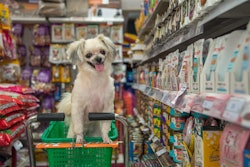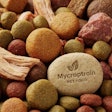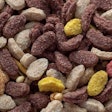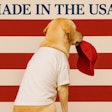
The global pet food market is expected to grow from $128.7 billion in 2024 to $226.53 billion by 2034, according to a report published by Allied Market Research. The forecast represents a compound annual growth rate of 6.1% over the 10-year period.
The report, titled "Pet Food Market - Global Opportunity Analysis and Industry Forecast, 2025-2034," attributes anticipated growth to rising pet ownership, increased awareness of animal health, demand for premium and functional products, and expanding distribution through online and retail channels.
Market segmentation and leading categories
Allied Market Research segmented the market by pet type, food type, sales channel and region. Dogs represented the dominant pet type segment in 2024 and are expected to maintain that position through 2034. By food type, dry food led the market in 2024 and is projected to continue its dominance. Specialized pet shops held the largest share among sales channels in 2024.
The report analyzed market performance across North America, Europe, Asia-Pacific and Latin America, Middle East and Africa regions.
Growth drivers
Allied Market Research identified several factors contributing to market expansion, including the rise of nuclear families, pet humanization trends and increased health awareness among pet owners.
The report noted that approximately 95% of pet owners view their pets as family members. Rising disposable incomes enable pet owners to invest in premium, organic and specialized nutrition products.
Since pet food accounts for approximately 76% of the pet care market, manufacturers are prioritizing the production of high-quality food that aligns with owners' tastes and preferences. As a result, the quality and ingredients of pet food play a crucial role in purchasing decisions.
Online sales channels have experienced significant growth, with Chewy.com and Amazon.com together accounting for over 80% of U.S. online pet food sales, according to the report. Other e-commerce platforms including Walmart.com, Petfooddirect.com and Petco.com also recorded growth.
Market challenges
The report identified pet obesity and product recalls as primary challenges facing the industry. Allied Market Research cited data from the Association for Pet Obesity Prevention indicating that over half of pets in the U.S. are overweight.
The 2025 Savage Pet incident involving avian influenza (H5N1) contamination was referenced as an example of recent recall events affecting consumer trust. The report recommended implementation of rigorous quality assurance protocols, traceability systems and third-party safety audits.
Regional performance
The North America pet food market leads globally, driven by pet humanization, increasing pet ownership, and rising awareness of animal health. Over 65% of U.S. households own a pet, contributing to robust demand for pet food products. Dry food held the largest market share in 2024, favored for longer shelf life and dental health benefits. However, pet owners increasingly prioritize nutritional value, prompting rapid growth in protein-rich, low-calorie options that offer higher moisture and essential nutrients. Premium and super-quality products continue to gain popularity, with manufacturers focusing on innovation to cater to each animal's life stage and specific dietary needs.
In Europe, the market has expanded rapidly, with growth influenced by smaller household sizes and an increasing preference for nutritional pet food. Countries such as Spain, the Netherlands, and Poland dominate regional sales. Dog food generated the highest revenue in 2024, though rising cat ownership is expected to drive future growth in cat food. Health issues such as obesity and arthritis have pushed consumers toward therapeutic and organic options. As pet humanization intensifies, European pet owners increasingly invest in premium nutrition solutions to support long-term health, boosting demand for healthier and functional food options.
In the Asia-Pacific markets, Japan leads the region, followed by Australia, while India and China are expected to grow the fastest due to increasing disposable incomes, urbanization, and shifting family structures. Premium and nutritious food formats are gaining ground, though Japan's market grows slower due to economic constraints.
In Latin America, Brazil dominates due to similar urban family trends, while South Africa's growth faces regulatory enforcement challenges. However, ongoing initiatives from industry associations, coupled with growing awareness of pet health and the demand for high-end food, are expected to boost market expansion across both regions in the coming years.
Key industry players
Companies identified in the report include Mars Petcare Inc., The Hartz Mountain Corporation, Big Heart Pet Brands, Nestlé Purina PetCare, Diamond Pet Foods, Hill's Pet Nutrition, Deuerer, WellPet, Blue Buffalo and Heristo AG.
The report noted leading companies in the pet food market are innovating with functional ingredients, personalized nutrition plans, and sustainable packaging solutions. Many are expanding product lines to include breed-specific, age-specific, and condition-targeted formulations.
Strategic mergers, acquisitions, and global partnerships are helping brands strengthen distribution networks. In addition, digital marketing, e-commerce platforms, and direct-to-consumer models enhance brand visibility and customer engagement worldwide.

















